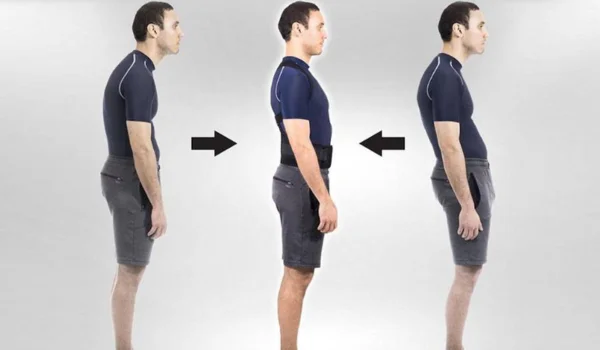Have you ever caught yourself slouching while working, scrolling on your phone, or watching TV? You’re not alone. In today’s screen-dominated lifestyle, poor posture has become one of the most common (and often ignored) health issues. But here’s the truth — your posture affects far more than just how you look. It influences your muscles, spine, breathing, mood, and even your long-term well-being.
In this article, we’ll explore why posture correction is essential for long-term health, what benefits it offers, practical ways to improve your posture, and answers to common questions people have about maintaining proper alignment.
🌿 What Is Posture and Why Does It Matter?
Posture refers to the way you hold your body while sitting, standing, or moving. Good posture means your body is aligned so that muscles, joints, and ligaments work efficiently with minimal strain.
When posture is poor — for example, slouching shoulders, a forward head tilt, or a curved spine — it puts extra pressure on your back, neck, and internal organs. Over time, this can lead to chronic pain, fatigue, and even digestive or breathing problems.
That’s why correcting your posture isn’t just about appearance — it’s about preserving your health for the long run.
💪 Key Health Benefits of Posture Correction

- Prevents Back and Neck Pain
Poor posture puts stress on your spine and neck muscles, leading to stiffness, soreness, and long-term pain. Correct posture distributes your body weight evenly, reducing tension and preventing strain injuries.
💡 Tip: Keep your ears aligned with your shoulders and shoulders in line with your hips when sitting or standing.
- Improves Breathing and Oxygen Flow
Slouching compresses your lungs, limiting their capacity. When you sit or stand upright, your diaphragm expands more freely, allowing deeper breaths and better oxygen intake — which helps you feel more alert and focused.
- Enhances Digestion
A hunched posture, especially after meals, can slow digestion and cause acid reflux or bloating. Sitting upright helps your internal organs function properly, allowing food to move smoothly through the digestive tract.
- Boosts Confidence and Mood
Good posture doesn’t just make you look taller — it makes you feel better. Studies show that people who maintain upright posture report higher self-esteem, improved mood, and reduced stress levels.
- Supports Joint and Muscle Health
Proper alignment reduces unnecessary wear and tear on joints. It ensures that your muscles work efficiently, lowering the risk of fatigue, stiffness, and injuries — especially in your lower back, neck, and shoulders.
- Improves Focus and Productivity
When your body is aligned correctly, blood and oxygen flow more efficiently to the brain. This enhances mental clarity and helps you stay more productive, especially during long hours of desk work.
- Promotes Healthy Aging
Over time, poor posture can cause spinal deformities and mobility issues. Correct posture keeps your bones and joints strong, helping you stay active and independent even as you age.
🧘 Practical Tips for Correcting and Maintaining Good Posture
Improving posture doesn’t happen overnight — but with small, consistent steps, you can train your body to stay aligned naturally.
Here are some easy, practical ways to fix and maintain good posture every day:
- Be Aware of Your Posture:
Start by noticing how you sit, stand, and walk. Awareness is the first step toward correction. - Use Ergonomic Furniture:
Invest in a chair with good lumbar (lower back) support. Adjust your desk setup so that your screen is at eye level and your feet rest flat on the floor. - Take Frequent Breaks:
Sitting for long hours strains your spine. Stand up, stretch, or walk every 30–45 minutes to keep your muscles flexible. - Strengthen Your Core:
A strong core supports your spine. Include exercises like planks, bridges, and yoga in your routine. - Adjust Your Sleeping Position:
Sleep on your back or side (not your stomach) using a supportive pillow that keeps your neck in a neutral position. - Practice Posture Exercises:
Try simple exercises like:- Shoulder rolls (10 reps)
- Chin tucks (hold for 5 seconds, repeat 10 times)
- Wall angels for shoulder mobility
- Avoid Looking Down at Your Phone:
The “text neck” is real. Hold your phone at eye level and keep your shoulders relaxed. - Wear Supportive Footwear:
Shoes with proper arch support improve your balance and posture alignment. Avoid wearing high heels for extended periods.
🌟 Summary: The Long-Term Benefits of Posture Correction
| Benefit | How It Helps Your Body |
| Reduces back and neck pain | Eases muscle tension and improves spinal health |
| Enhances breathing | Expands lung capacity for better oxygen flow |
| Supports digestion | Prevents bloating and acid reflux |
| Boosts confidence | Improves body language and self-esteem |
| Protects joints and muscles | Reduces wear and tear and prevents fatigue |
| Improves focus | Increases blood and oxygen flow to the brain |
| Promotes healthy aging | Prevents deformities and maintains flexibility |
🧍 Simple Daily Posture Correction Routine
Morning:
- Stretch for 5 minutes after waking up.
- Do 10–15 minutes of yoga or light mobility exercises.
Workday:
- Sit upright, feet flat on the floor.
- Keep your screen at eye level.
- Take a 2-minute walk every hour.
Evening:
- Avoid slouching while watching TV or using your phone.
- Practice deep breathing while sitting upright.
Before Bed:
- Sleep on your side or back with a supportive pillow.
- Do a short neck and shoulder stretch before lying down.
❓ Frequently Asked Questions (FAQs)
- What causes poor posture?
Poor posture often results from prolonged sitting, weak core muscles, poor ergonomics, and lack of awareness. Using smartphones or laptops for long hours without breaks also contributes to slouching.
- Can posture correction really reduce pain?
Yes! Correct posture relieves strain on your muscles and joints, which reduces chronic pain — especially in the lower back, shoulders, and neck.
- How long does it take to improve posture?
You can start noticing changes within 2–4 weeks of consistent practice, though full correction may take a few months depending on your lifestyle and habits.
- Are posture corrector belts helpful?
Posture braces or belts can help temporarily remind you to stay upright, but they shouldn’t replace exercise or muscle strengthening. Use them as a supportive tool, not a permanent solution.
- Can exercise fix bad posture?
Absolutely! Strengthening your back, shoulders, and core through regular exercise (like yoga, Pilates, or bodyweight workouts) is one of the best ways to naturally correct posture.
🌈 Final Thoughts
Correcting your posture isn’t just about standing straight — it’s about building a stronger, healthier foundation for your entire body. With consistent awareness, simple exercises, and small daily adjustments, you can reduce pain, boost energy, and protect your long-term health.
Start today — sit tall, stretch often, and move mindfully. Your future self (and spine) will thank you!

Hello, I’m Kapil Kumar, a seasoned SEO expert and blogger at WinnersList.in. My mission is to spotlight exceptional individuals and organizations across various domains. Through curated lists, profiles, and inspiring stories, I aim to celebrate outstanding achievements and inspire the next generation of champions. Join me in this journey.
